By Lou Melini — During the 1970s, rollers were standard equipment for cyclists during the winter. We used them for pre-race warm-ups, to “time trial” without the interference of traffic, or to simply try to improve balance and bike handling. I used rollers in my parents’ basement and away from home while attending school. I moved to Utah in 1979 and continued to use rollers until mountain bikes became part of my quiver. With the wider MTB tires, I could navigate snow and ice, ending my riding on rollers era. These days, I generally use a spin-style bike for those occasional days I do ride indoors, as well as to do the intensity work that I can’t seem to duplicate on the road.
For those not familiar with rollers, they consist of 3 cylinders in a metal frame — two cylinders in the rear to cradle the rear tire and one in the front on which you set your front tire. A band connects the front cylinder and the forward rear cylinder. To start your ride, you set your bike on the rollers, carefully mount the bike, and start pedaling. Soon you will feel like you are riding down the road, though I wish it were really that simple and easy.
When Jason Bynum called to ask me if I wanted to demo a set of rollers from his new company, I jumped at the chance to return to an earlier time in my life. I have known Jason for several years, starting when he worked with my son Ben at Millcreek Bicycles (now Hangar 15). Jason’s integrity is impeccable, one reason to test a product he is involved with.
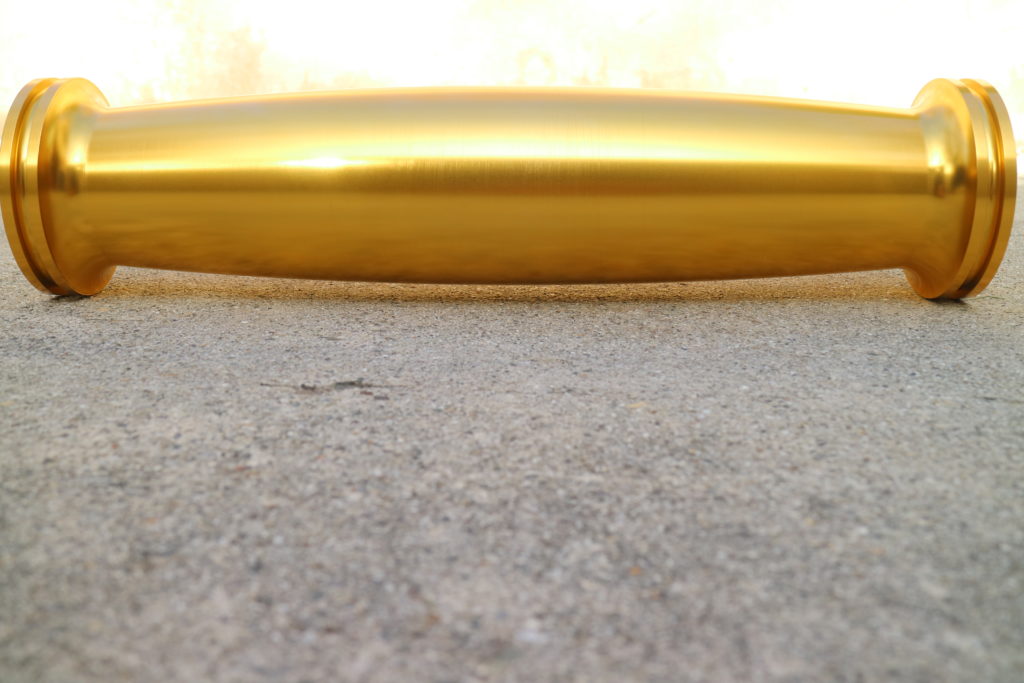
Rollers are a niche product in the cycling marketplace, and Crown Rollers are unique in that niche space. The central part of the cylinders are raised or “crowned”, thus the name. The two rear cylinders are also slightly elevated to create a level axle-to-axle plane. According to the company website, this produces a more accurate feel like you’re riding on the road.
Immediately after acquiring the rollers from Jason to start my review, I realized that nostalgically starting where I left off 35 years ago was not going to happen. Rollers can be tricky to ride and there is a learning curve, a statement that is replicated on the website.
There are a couple of steps one needs to do before the first ride. The first step is measuring the wheelbase of your bike and then adjusting the frame to properly position the front cyclinder for your bike’s wheelbase. The rollers come with a fit chart making this step easy for the initial set-up.
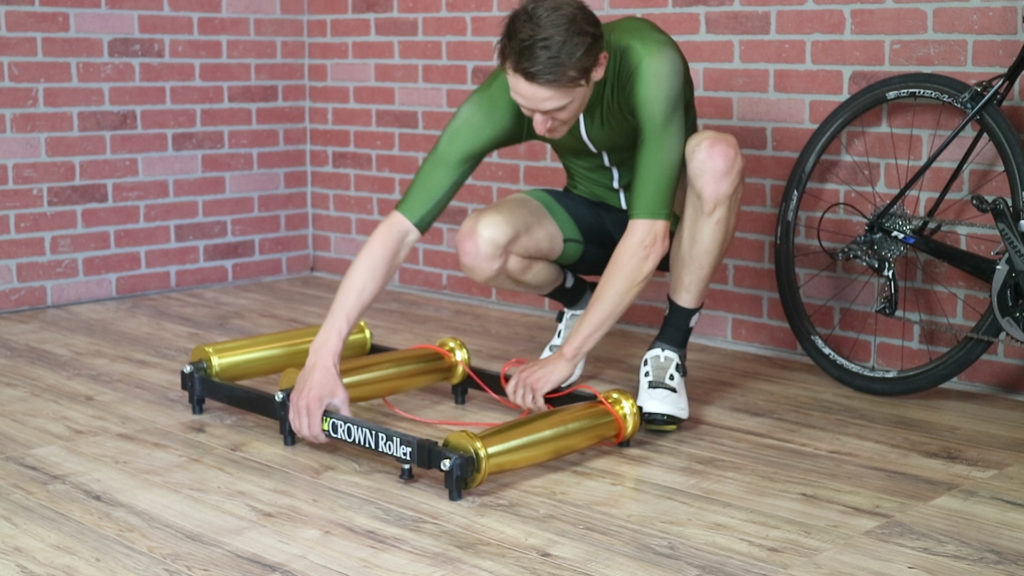
The next step is to place your rollers next to a stable object, such as a bare wall, the back of a couch, or some other piece of large furniture that isn’t going to easily move. In my case, I used a pool table on one side of the rollers and an old school desk on the other. I was now ready to begin my test, which consisted of four 5-minute rides followed by three 45-minute rides.
My initial goal was to ride the rollers and simulate various maneuvers that I do when I ride my spin bike such as sprinting, standing, grabbing a damp cloth to wipe my sweaty forehead, and riding with one hand or no hands on the handlebars. With the rollers, I also had the additional task of shifting to change resistance vs. turning a knob on the spin bike.
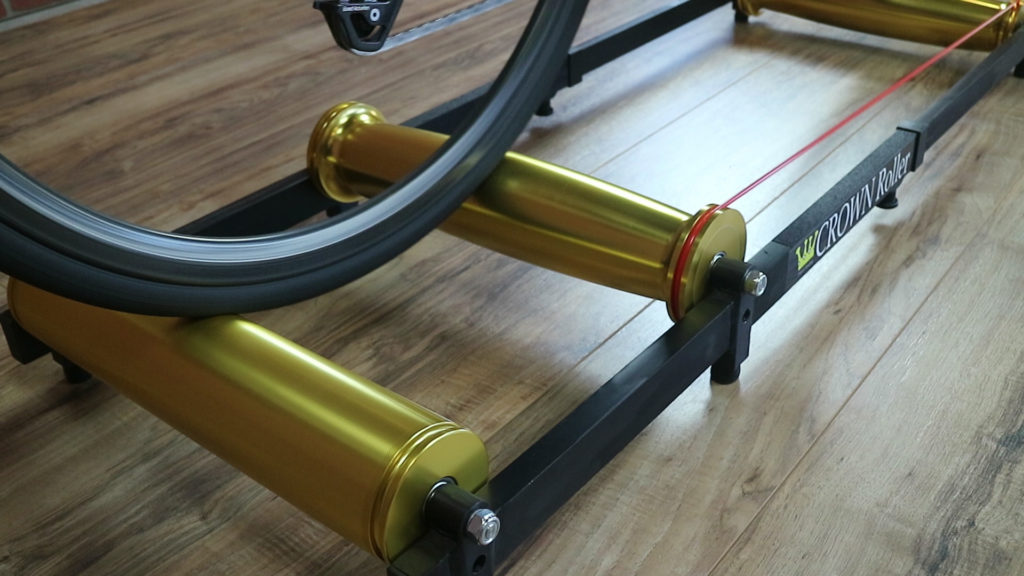
I took my road bike from the garage and set it on the rollers to begin the test, and quickly realized that even though the tires seemed to be inflated, I needed to pump them up to 100psi to make riding easier, a recommendation stated on the website. I also followed the website’s suggestion to use running shoes instead of cycling shoes and clipping in to my pedals during my initial 5-minute tests.
I used the 5-minute rides to try to meet my simulation goals. Sprinting, spinning with a high cadence, and shifting were easy tasks. Riding with one hand or no hands, reaching for a sweat rag, and standing were less so. I found it easier to reach for a sweat rag, when it was sitting on a platform set at roughly hip height next to the rollers. With focused repeated tries, I could briefly ride out of the saddle, or with one hand or no hands on the bars.
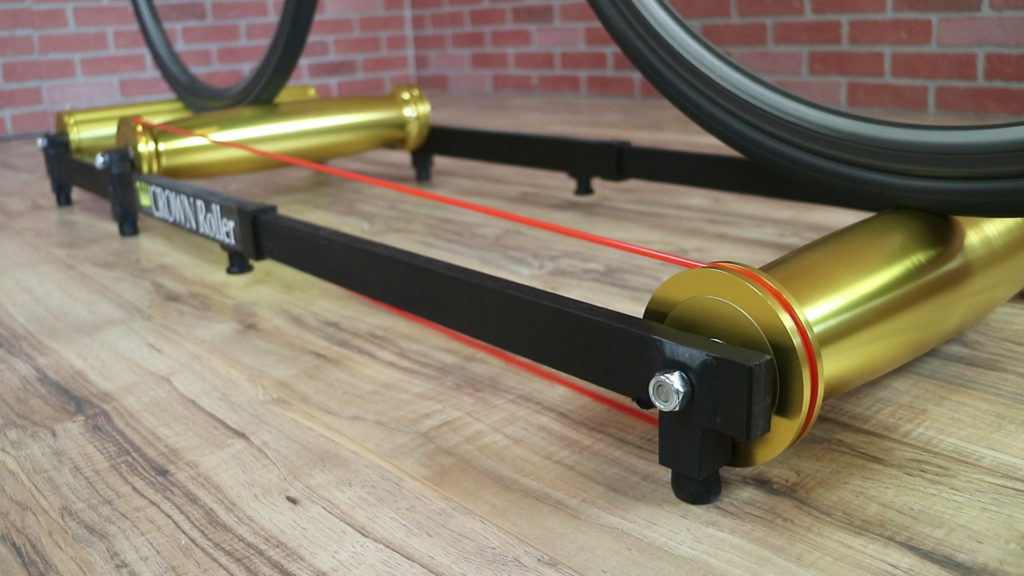
The three 45-minute rides on the rollers matched the typical duration of my spin bike sessions. For these, I used my usual cleated shoes. I tested with two different bikes—my road bike mounted with 700Cx23mm tires and a 38.5-inch wheelbase, and my touring bike with 700Cx32mm tires and a 41.3-inch wheelbase.
Changing the length of the rollers was a bit finicky when swapping bikes with different wheelbases. I used the road bike for sessions 1 and 3.
The initial first minute of each ride was clumsy but I soon was spinning smoothly, although I found myself at times drifting perhaps 6 inches or so on either side of midline, a bit more than I would normally want.
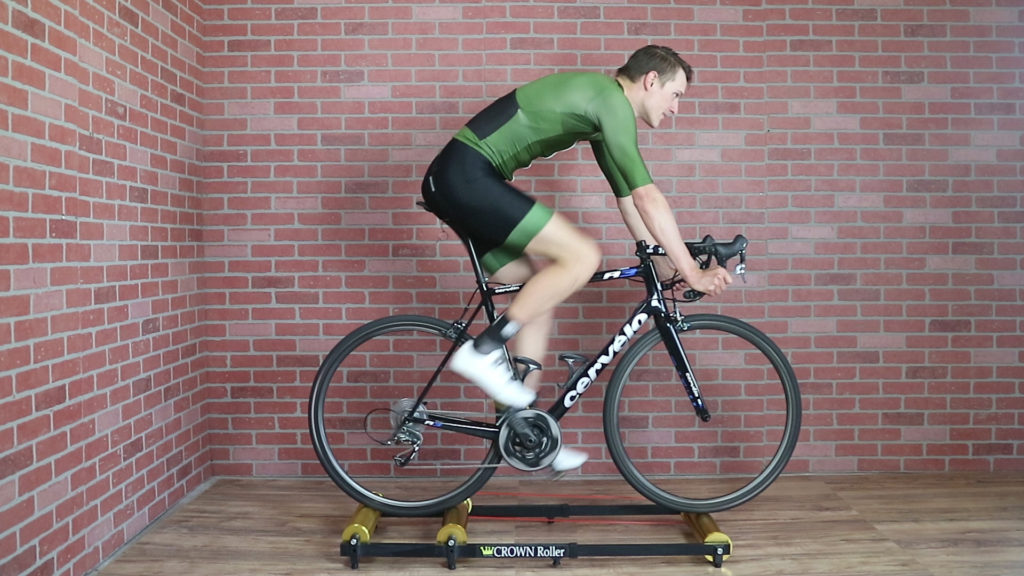
During these sessions, I purposely watched La Course en Tête: the Eddy Merckx story, as I knew there was a scene in the film where Merckx was shown training on his rollers. He also moved side-to-side from centerline, although somewhat less than I did. The way I figure it, if Eddy moved, then I am also allowed to move. By imagining being on the road and avoiding a few imperfections or obstacles, the movement on the roller felt normal. A few times, I did move to the edge of the rollers, bumping the pool table with my thigh.
Crown Rollers have an elevated ridge on each end of the cylinders, so I never really felt that I would come off the edge. I did feel more stable on the rollers with my touring bike, perhaps due to its wider tires or the longer wheelbase.
The touring bike has a high gear of 42×11 so I was able to easily shift into that gear and spin at 90 RPM or more. With the road bike’s higher gearing, I was able to obtain more resistance and rode shorter sprints in the 50×11. With either bike, I was able to obtain a good workout comparable to a ride on the spin bike. At 127 pounds and 68 years of age, this was plenty. A younger or stronger rider may need a 53-tooth chain ring to generate more resistance.
The advantage of a spin bike or a resistance trainer that locks your rear wheel is obvious; there is more stability. After making adjustments for seat height and handlebar reach one can just get on the bike and ride. As the Crown Roller website states, “if you want a training session that is simple and foolproof, a rear wheel trainer or spin bike may be more suited for your needs”.
On rollers, however, the inherent learning curve and occasional sense of instability better simulates a ride on the road, and helps you gain balance and bike handling skills. If you ride indoors frequently during the winter months, there can be much gained by adding the use of rollers to your training regimen. I do suggest that you read the “Intro to Riding Rollers” and the “FAQ” on the Crown Roller’s website (www.crownroller.com) for more detailed information.
For more insight to rollers and about Crown Rollers in particular, I asked company co-founders Jason Bynum and Charles McNall a few questions.
Cycling Utah: Jason, great to catch up with you. Glad to hear that the family is doing well, including the little Bynum. How did you become involved with Crown Rollers?
Jason Bynum: I became involved with Crown Roller by being introduced to Charles McNall, Founder, President, Engineer, and overall genius of Crown Roller.
A friend knew that I was looking for way to leverage my 20ish years in the cycling/outdoor industries, while still focusing on being a stay-at-home dad for our daughter, who was 6 months old or so at the time. This friend showed me a video that Charles had made with a prototype set of rollers. As soon as I saw the shape of the roller, I knew it was a brilliant idea and that I wanted to be involved.
I was associated with Mike Hanseen at Millcreek Bicycles (now Hangar 15) in Salt Lake City, who is considered a master bike fitter. My experience working with Mike made the rollers click as a great idea. Our friend put us in touch with Charles, and off we went!
It’s a small business, so Charles and I both have numerous roles. In short, I am a co-founder with Charles, and I am Director of Operations and Director of Business Development. Fun titles, but Charles and I are both just doing everything that needs to be done to run a business!
Charles McNall: Crown Rollers came about as I, like many people, experienced their first frustrating roller session. As I focused on not flying off my rollers, I thought I can fix this, there has to be a better roller shape. I 3D-printed some large, deep-trough concave rollers and found them impossible to ride. If I wasn’t dead-centered then I shot off the side quickly. In a last ditch effort, I tried the opposite shape and found that to my amazement, it pulled me right to the center. It took about 20 versions to finally end up with a profile that was aggressive enough for beginners but not too aggressive for a veteran.
CW: What are the unique features of Crown Rollers and how do those features affect how one rides rollers? How do the features of Crown rollers differ from other rollers on the market?
JB: What makes Crown Roller unique is the shape of our front and middle rollers. Traditional rollers have been around for more than 100 years, and have 3 uniform cylinders. A set of rollers may come in different sizes such as 3-inch or 4.5-inch diameters, which determines the inherent rolling resistance (more on that in a moment).
Some modern roller manufacturers have attempted to add stability by creating a concave-parabolic shape, like a very gentle hourglass. This seems logical, but as we found, physics dictates the exact opposite. A convex or ‘crowned’ shape adds stability.
Here is why: a larger diameter roller has LESS rolling resistance, which is easier. A smaller diameter roller has MORE rolling resistance, which is more difficult. Since our rollers have a larger diameter in the middle, and smaller diameter as you move away from the middle, the path of least resistance is at the center of the roller.
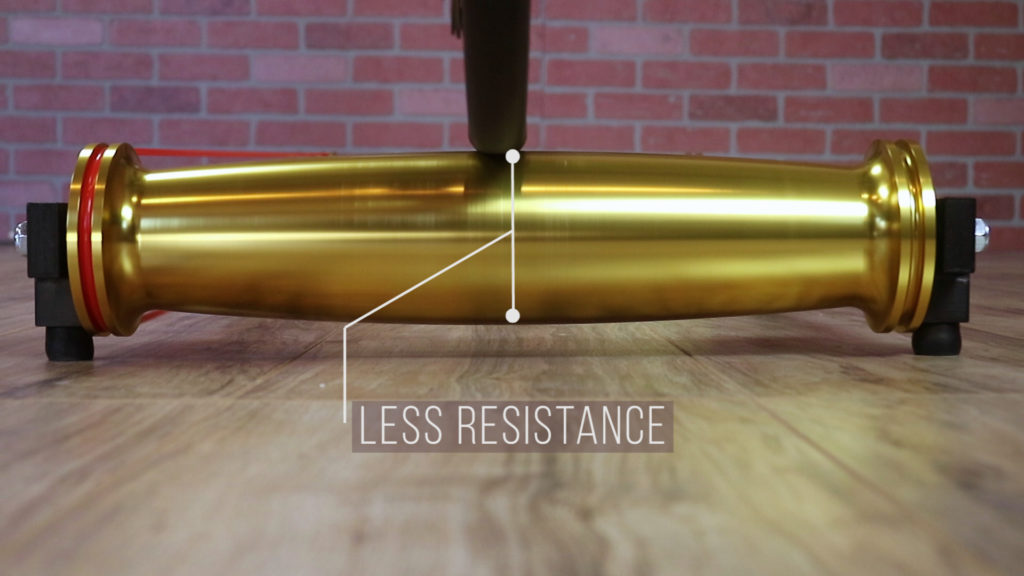
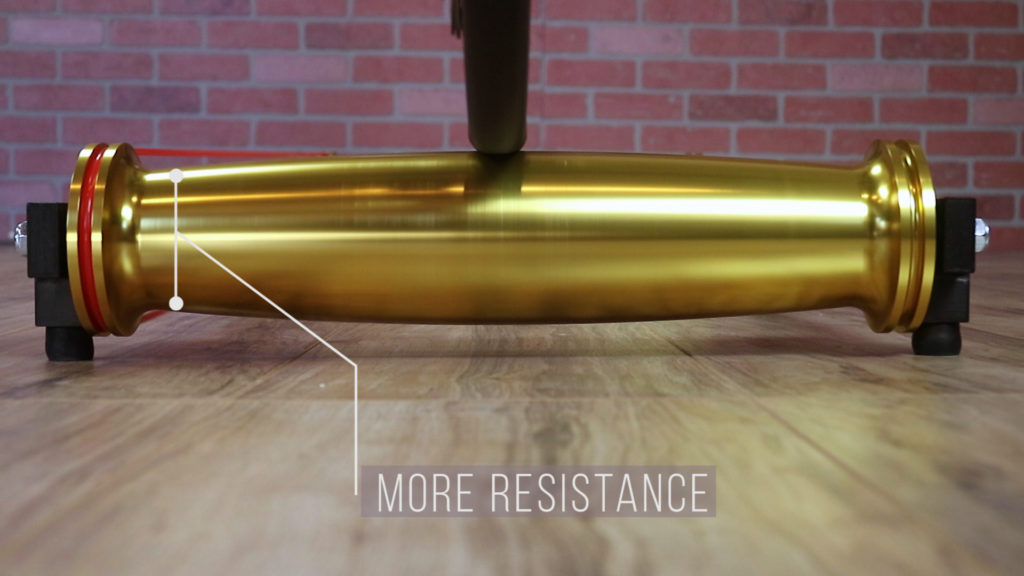
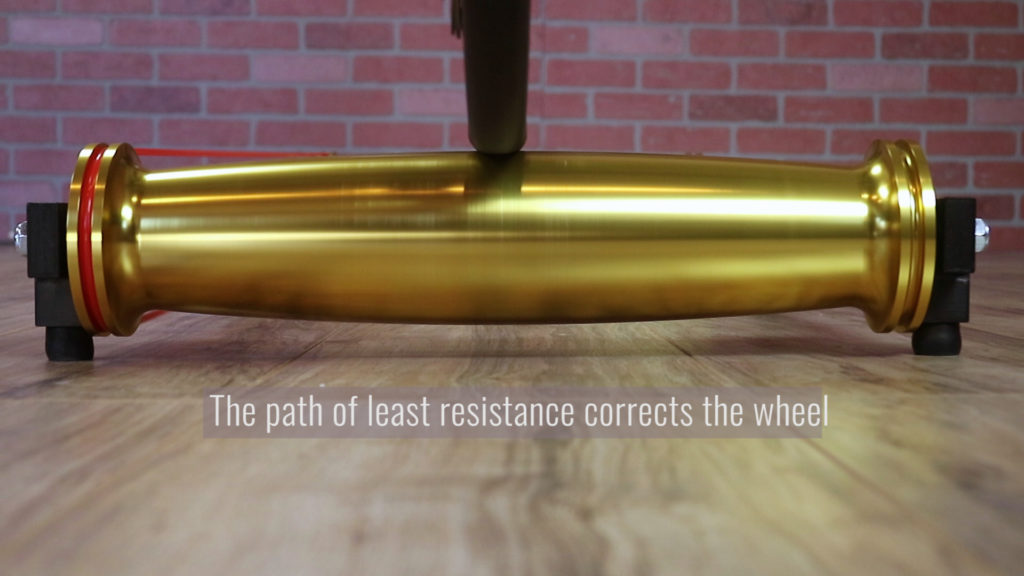
Additionally, as you move away from the center of the roller cylinder, the uphill side of your tire (toward the middle of the roller) is making contact with the roller, while the downhill side of you tire (toward the outside/frame) is not. This means the uphill side has traction and wants to climb back to the top of the crown. This may be a bit tricky to understand, but it’s no different than rubbing your tire along a curb or rut and your tire wanting to jump up the side of the curb or rut.
The correcting effect of our rollers is rather gentle, and that is by design. We experimented with about 20 iterations of the roller shape to land on a profile that encourages you toward the center, but does not aggressively move you toward the center.
Lou, you noted in one of our emails that you deviated from center a bit more than you thought normal. Since our profile is a continuous curve, there is no flat spot at the apex of the roller. This means that you will largely be in a side-to-side dance over the top of the roller. To me, it’s not much different than holding your wheel on the yellow line while riding on the road. With concentration, I keep my wheel on the line pretty well, but if I’m relaxing and just letting my bike move, I deviate to either side a bit.
Another feature of our rollers is our ‘Level Fit Frame.’ Since your front wheel rests on top of the front roller, and the rear wheel rests between the middle/rear rollers, on most rollers, the front of your bike sits higher than the back by about 3cm. We corrected for this by elevating the middle and rear rollers 3cm relative to the front roller. This provides a level axle-to-axle plane, so your position on the bike, is the same on or off the rollers.
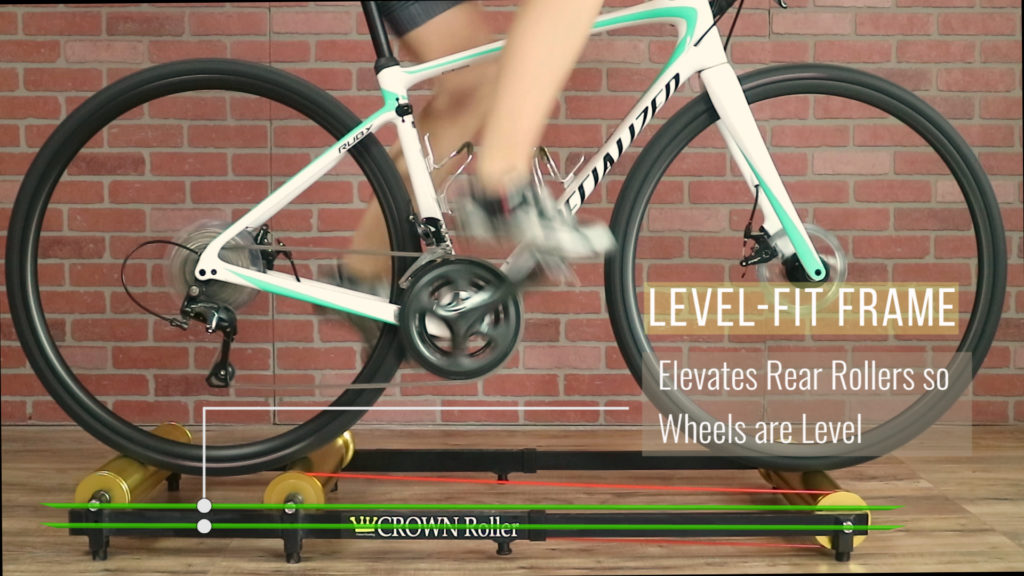
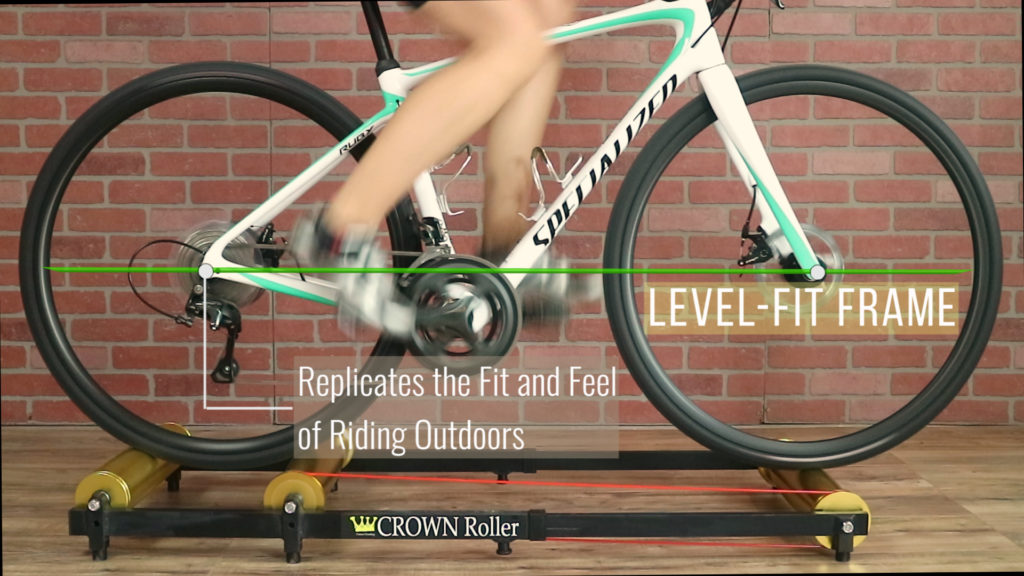
CW: How does where the wheels sit (either too far forward or aft of the front roller) affect the performance of the rollers?
JB: Our frame is a pretty key piece of our rollers as well. Since we elevate the middle and rear rollers, we are able to make a telescoping frame that compresses to a remarkably small size for travel/storage.
Our frame also has numerous adjustment positions to accommodate a wide range of wheel bases from a small road bike with 650c wheels to a long 29” wheel XC mountain bike, a range of about 36-46 inches measured axle-to-axle.
Due to the shape of our rollers, setting the frame to the correct length for your wheelbase is very important and easy to do. Each set of rollers comes with a Fit Chart to help you determine which adjustment position is best for your bike.
To adjust, we use a spring-loaded pin on the bottom side of each frame. These pins lock open when turned, then release when turned again. Locking the pins open makes it much easier to adjust the frame from its fully collapsed position. As you noted, the pins can be a bit finicky. A future round of production will likely see these become a bit more user-friendly.
If the front roller is adjusted too far forward or back, riding simply won’t feel as fluid. I think there is some wiggle room for each rider vs. the Fit Chart. For each wheelbase measurement, a rider should feel free to explore plus-or-minus one hole to see what feels best for them. As long as the front axle of the bike sits approximately 1cm behind the axle of the roller, the ride should feel right.
CW: What is the procedure for purchasing your rollers.
JB: Customers can purchase our rollers from our site at www.crownroller.com. People in the Salt Lake area can select the free Local Pickup option, and Charles or I will meet you with your new rollers!
CW: Is there anything else you’d like to tell us?
CM: We set out to solve the age-old problem of people being too scared to try rollers. It’s a problem that has been holding people back from the best possible indoor riding experience. While it has been an uphill education battle to make rollers cool again, the overwhelming positive customer feedback continues to push us to bring Crown Roller to the cycling community. We are proud to have a product that works well, is built solid and customers love.

